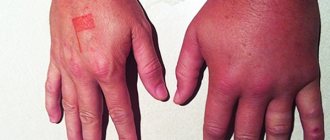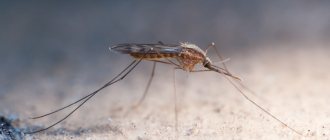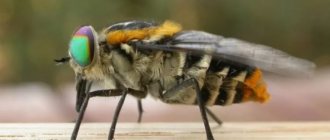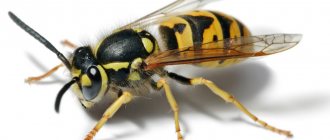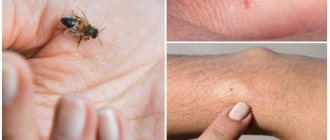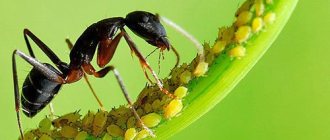Blog articles Beekeeping
Beekeeping
Economics of beekeeping
Beekeeping news in Russia
Beekeeping news in the world
Honey
Propolis
Bee bread
Zabrus
Royal jelly
In the world about bees
Apiary
Bees
News from honey fairs
From the history of beekeeping
- What you need to know about bee stings
- Bee venom: its components and their properties on humans
- Symptoms and consequences of a bee sting
- Providing first aid for bee stings for adults and children
- When medical help is needed
- Folk first aid remedies after a bee sting
- What not to do when helping with a bee sting
Bee stings are the natural protection of bees from enemies
Bees pollinate many plants, produce honey, and valuable medicines are obtained from the waste products of these insects. But it’s not for nothing that they say: “Eat honey, but be afraid of the sting.” Bee stings are not only very painful, but in some exceptional cases they can even lead to death.
For the sake of fairness, it should be noted that a bee stings only when it is forced to defend itself, because after losing its sting weapon, it dies. The bee has a sharp, hollow stinger with jagged ends, through which poison is injected into the blood of the victim. Since the sting, along with the poisonous capsule, remains in the body of the bitten person and goes deeper into the wound, this contributes to its spread throughout the body.
Most often, single stings are not dangerous to humans, but multiple stings can cause general intoxication of the body. That is why safety precautions play a huge role in beekeeping. The beekeeper always wears protective clothing when going to the hives. It is the composition of the poison that causes burning and inflammation, causing allergic reactions. In winter, the toxic properties of the poison are much weaker than in the warm period. Worker bees aged 7 to 20 days are considered the most poisonous.
Why do bees sting?
This peaceful insect attacks only in case of danger and dies. Under no circumstances should you wave your arms or drive away a bee if it flies near you, so as not to ask later what to do if a bee bites your hand.
Follow simple rules to avoid being attacked by these insects:
- do not use perfume with strong odors, do not abuse alcoholic beverages outdoors
- When going outdoors, choose clothes in soft colors;
- don't try to kill the bee, don't run;
- on the days of honey pumping, when the bees are most aggressive, do not be near the apiary;
- do not walk barefoot in nature, so as not to step on old bees - they no longer fly much, but they sting just as painfully;
- On a tour of the apiary, dress in such a way as to be protected from bee stings, listen to the advice of the accompanying person.
Bee venom: its components and their properties on humans
Bee venom or, as it is also called, apitoxin is produced by worker bees. It is a thick transparent liquid with a slight odor of honey and a bitter taste. Apitoxin has a very complex composition and has a strong active effect. The poison contains not only proteins and amino acids, but also fat-like and mineral substances. It consists of 50% water.
The main dry element of apitoxin is melitin and other toxic polypeptides, which, interacting with organic acids, magnesium and proteins with enzymatic properties (phospholipase A2, hyaluronidase, acid phosphatase) make it therapeutic. Hyaluronidase, for example, promotes the rapid spread of apitoxin, and phospholipase A2 reduces blood clotting. But histamine, which is part of apitoxin, causes swelling of the tissue in the bitten area and is the main cause of anaphylactic shock, but at the same time, thanks to it, apitoxin helps reduce blood pressure and dilates blood vessels.
Bee venom contains the following amino acids:
- alanine;
- isoleucine;
- arginine;
- cystine;
- glycine;
- tryptophan.
Also, minerals such as manganese, sulfur, phosphorus, iodine and others were found in it. The sting causes a strong burning sensation due to the acids (formic, phosphoric, hydrochloric) included in its composition. The effect of poison on a person depends not only on its amount entering the blood, but also on the place of penetration and individual intolerance.
Bee sting: symptoms and consequences
The very first thing a bitten person feels is a burning sensation and severe pain at the site of penetration. After one or two minutes it swells and turns red. If you look closely, you will see a small black sting on the body, which must be removed. Usually these symptoms gradually decrease, and after three to four days they completely disappear. Approximately 80% of people can safely tolerate up to 5 simultaneous stings without serious consequences. 19% of people may have:
- malaise;
- weakness;
- dizziness and headache;
- low-grade fever;
- hives.
In some people who are stung and if a large amount of toxic substances enters the blood, these symptoms may include diarrhea, severe vomiting, low blood pressure, breathing problems, and convulsions. Sometimes, especially if the attack was in the facial area, hearing loss is observed. And only in 1% of people, a bite, even a single one, can lead to anaphylactic shock. The most dangerous are stings in the neck, eyes, face, and tongue. Typically, allergic manifestations occur fairly quickly within approximately 5-10 minutes. The speed of allergy development and intensity depends on how often bees have bitten before.
Hymenoptera bites
Mosquitoes, midges, and horseflies do not have poisonous glands; when they bite, they inject a special substance into the wound that prevents blood clotting. The reaction to their bites is usually only local. A person is able to endure multiple bites of these insects (up to 100 or more) without disturbing the general condition. To reduce local manifestations, try using the following remedies. Dipping your finger alternately in water and dry soda, rub the bites with your finger; You can also smear it with a strong soda solution. Baking soda is believed to somewhat reduce swelling and itching. Menovazin has a good analgesic and antipruritic effect, but it should not be used by people with hypersensitivity to novocaine. Orthophen and butadione ointments reduce inflammation and itching. Star balm helps some people well. There is a special cream “OFF” after bites. To prevent infection of the bite sites, they can be lubricated with brilliant green. Folk remedies recommend using grated new potatoes, crushed onion or garlic gruel, and parsley leaf juice. You can ward off insects with special means: creams and lotions (“Moskitol”, “OFF”, “Taiga”, etc.), which are applied to the skin and clothes, repellent aerosols, smoking coils, etc. Remember that all these products are toxic and are not recommended for use by children under 3 years of age and pregnant women.
Bees, bumblebees (they bite only once in a lifetime, after which they die), wasps and hornets (they can sting several times) “reward” us with poisonous bites. The local reaction to the bites of these insects is usually very pronounced. The development of significant swelling is typical, which, although it is a local reaction, can be dangerous if located on the face, especially in the lip area or inside the oral cavity. Allergic reactions to the bites of these insects are quite common. Urticaria is a rash of blisters merging with each other against a background of redness of the skin, accompanied by severe itching. Can be located on any area of the skin. Quincke's edema ("giant urticaria") is a rapidly growing, limited swelling of the skin or mucous membranes. It can occur not only directly at the site of the bite, but also at any other site. Its “favorite” localization is the face, oral mucosa, soft palate, limbs, and genitals. Allergic swelling of the larynx is especially dangerous. A rare but very dangerous reaction is anaphylactic shock. Within a few minutes, the victim develops shortness of breath, severe chills, fear of death, heart rate increases, blood pressure drops sharply and coma occurs. Locally there is a blister, rapidly growing swelling, hemorrhage.
Providing first aid to adults and children
The most important thing to do after being bitten by a bee is to quickly remove the sting. Usually it does not go deep and therefore it is quite easy to pull it out. To do this, you should use tweezers; if you don’t have them at hand, you should carefully grab the sting with clean nails. If it breaks off and a piece remains in the wound, then you can remove it using a thin needle (pin), having previously disinfected them. After this, you need to disinfect the wound with an antiseptic solution or wash it with water and laundry soap.
To reduce itching and burning, apply a cotton swab soaked in ammonia or salt solution to the wound. A cold compress will help relieve swelling and stop the spread of apitoxin. Place a piece of ice wrapped in a cloth, a heating pad filled with cold water, or just a towel soaked in water on the wound. The main thing is that the objects applied to the stung area are clean, otherwise infection may occur. To remove toxic components from the body as quickly as possible, you should drink plenty of fluids.
If a person is prone to allergies, then he should take an antihistamine as a preventative measure. If a severe form of allergy develops, the person who has been bitten must be put down, wrapped warmly, urgently call a doctor, or taken to the hospital as soon as possible.
Video: First aid for a bee or wasp sting
If a bee has bitten a child, first aid is provided in the same way as for an adult. To treat a wound, you should not use alcohol-containing antiseptics, but rather use hydrogen peroxide or soapy water. To prevent an allergic reaction, it is recommended to give a child under 10 years of age an antihistamine or treat the damaged area with an antiallergic cream.
When medical help is needed
Most often, after providing first aid for a bee sting, a person does not need to see a doctor, but sometimes this cannot be avoided. You must immediately call an ambulance or take the person bitten to the hospital if:
- loss of consciousness;
- spread of allergic rash;
- rapidly increasing swelling;
- respiratory arrest;
- beginning shortness of breath;
- strong heartbeat;
- convulsions;
- in case of vomiting;
- attack and bites of more than 15 insects (child, elderly people, pregnant women more than 5).
Bee sting - harm or benefit
Although bee stings can be harmful to health and dangerous for the elderly, children and allergy sufferers, there is also a direction called apitherapy. This trend in folk medicine suggests using bee stings to cure many different diseases.
We recommend reading! Omshanik for bees: what is it, types, do-it-yourself construction and features of wintering bees (110 photos and videos)
Here no one thinks about how to remove a tumor if you are bitten by a bee, because the effect of their venom is considered therapeutic. In particular, with the help of apitherapy they treat high blood pressure, heart and blood diseases, inflammatory processes, improve the functioning of the immune, hormonal and enzyme systems, increase bone regeneration...
Despite excellent reviews about such treatment methods, you should not fall for fancy advertising and start apitherapy without consulting a competent doctor.
Folk first aid remedies
There are many folk remedies that help provide first aid for a bee sting. All of them are as effective as medications, but they are allowed to be used only after the sting has been removed and if the person is not allergic to bee waste products. An ordinary coltsfoot leaf applied to the inflamed skin with the cold side reduces pain and relieves swelling. Burdock and plantain leaves have exactly the same properties. It is recommended to use a validol tablet as a cooling agent, which should be applied to the bitten area as soon as possible.
To disinfect the affected area, it is recommended to treat the affected area with garlic or onion juice, but since the juices of these plants can cause burns and severe irritation, it is not recommended for the child to treat the penetration site with them. It is also good to squeeze dandelion or parsley juice onto the wound to relieve pain. To reduce irritation and burning, the skin is lubricated with vegetable oil, preferably olive oil.
Soda solution also relieves itching well; it needs to be used to lubricate the redness every 20 minutes. If you don’t have any antihistamines in your medicine cabinet, you can dissolve an aspirin and activated charcoal tablet in 50 ml of warm water, moisten a bandage and apply it to the bitten area.
Dangerous situations
These include a bite from a woman during pregnancy, a sting from a small child, a bite to the head, finger, neck, soft tissue or eye. We propose to analyze each case and its harm separately.
Stinging Children
A bee sting is much more painful for a child than for an adult. In addition, the area affected by the insect, be it a hand or just a finger, can become inflamed. If it happened that a child was bitten by a bee, what to do in such a situation?
First you need to provide first aid. After the sting is removed, the wound must be treated with a disinfectant and anointed with “Rescuer” ointment. It has a pleasant aroma and is gentle on children's skin. If such an ointment is not available at home, you can use a slightly pinkish solution of potassium permanganate.
If assistance is provided correctly and in a timely manner, the swelling and other symptoms of the bite should disappear on the second day. If body temperature rises, chills appear and signs of intoxication appear, the child must be urgently taken to a medical facility.
What if a bee stings a pregnant woman?
Many people wonder what to do if a woman is stung by a bee during pregnancy? After all, you can be attacked by these insects in a clearing, meadow, park, garden or in an outdoor cafe. If a woman is bitten during pregnancy, it will not harm the health of the child. The only thing that can cause discomfort is pain, itching, and swelling. In the absence of an allergic reaction, the consequences of the bite will have to be endured, since treatment with drugs during pregnancy can negatively affect the condition of the fetus.
Bite into soft tissue
If the bite is on soft tissue, for example, on the lip or tongue, treatment should be aimed at relieving swelling. If your lip is stung, as in the photo, you can use Rescuer ointment. But why not use an effective folk remedy? After all, the bite site can be smeared with an aqueous solution of soda. Literally in 10 minutes there will be no trace of swelling left.
In the case when a wasp or bee sting occurs on the tongue, it looks really scary. Self-treatment may worsen the situation. After all, if the swelling spreads to the larynx, it can cause suffocation. That's why it's better to see a doctor right away.
Bite to the head or neck
When a wasp or bee stings the head or neck, the most severe consequences are observed. In addition to burning pain, redness and swelling appear on the skin, which quickly spreads to nearby tissues. After providing first aid, the victim must be taken to a medical facility, where they will take the necessary measures and tell you what to apply to the stung areas.
Bite in the eye
If the organ of vision is damaged by a wasp or bee, the eyelid closes completely, as severe swelling appears on it. Against this background, complications may arise in the form of blepharitis, conjunctivitis or panophthalmitis. That’s why you shouldn’t waste a minute trying to apply folk remedies to your eyes, but consult a doctor immediately.
